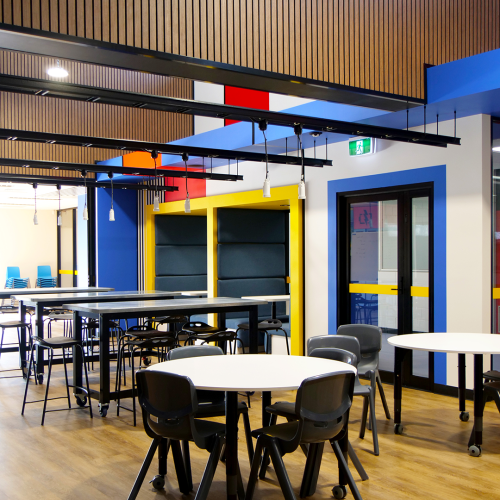Picnic Point High School upgrade
- Client:
- School Infrastructure New South Wales (SINSW)
- Location:
- Picnic Point, New South Wales
- Features:
- four new general learning spaces
new TAS workshops and new TAS learning spaces
new Visual Arts workshop and new Visual Arts learning spaces
new Music learning spaces
new computer learning space
upgraded and expanded Administration and Staff facilities
landscaping and external improvements - Credits:
-
Iain Stewart
Oliver Wellings
- Project Website:
- Visit the project's website
Picnic Point High School (PPHS) is a government high school located in the Picnic Point, New South Wales suburb. The redevelopment project, which involves the refurbishment of some existing buildings and the construction of a new learning facility, responds to the expansion of the school’s catchment to provide the East Hill’s and Picnic Point communities more choices for co-education.
A master planning process comprised of a thorough site analysis, site testing, a staging strategy, and the establishment of key design principles determined a site to the south east of the school grounds for the new building.
The existing PPHS Buildings are all oriented north south on their long axes, with east and west exposure resulting in unwanted heat load and glare. The decision was therefore made to orient the new (Technical and Applied Sciences) TAS building to north, with access walkways off the north façade, all in keeping with School Infrastructure’s Design for Modular Assembly (DfMA) Guidelines. The location chosen for the building ensures surveillance over the east part of the school grounds, until now ‘out-of-bounds’ to students, thus opening the grounds for use at recess for activity and recreation.
Two high-value Angophora trees and a Scribbly Gum are situated just north of the building, providing a shaded setting for an outdoor learning space, and with generous tree canopy around the site, creates a micro-climate for the building’s immediate context.
TAS Unit wood and metal workshop units are located on the ground floor, with an acoustically insulated Music Unit, and Visual Arts Unit accommodated on the first floor. The steep fall of the site made possible an under-croft providing additional storage/workshop space and a kiln for the arts unit.
The development is located just north of the Georges River National Park, the George’s River is the traditional boundary between the Dharawal People to the south and the Dharug to the north. The proposed colour, material palette, and façade concept is informed through observations of the Georges River National Park context and arranged rhythmically according to the major scale in reference to the building’s hosting of the Music Unit.
A Dharug piece of music is interpreted architecturally and adds relief and interest to the north walkway elevation’s vertical screening. The building, with its landscape inspired facade, is supported by its landscape setting, which also draws reference from the George’s River National Park and connections to Dharug country.
The redevelopment of PPHS is essential to the future learning needs of its students and supports growth in the local economy.
Key features:
- School Masterplan
- 3 new general learning spaces
- Upgrade and expansion of administration and staff facilities
- New Technical and Applied Sciences (TAS) unit to replace existing
- Relocation of the Visual Arts and Music Units to meet additional capacity for 2031
Collaborators:
- AECOM: Structural, Civil, Mechanical, Electrical, ICT & Hydraulic Engineering
- Arcadia: Landscape Architects
- Philip Chun: BCA Consultant
- HKA: Project Managers






